You can easily create immune-boosting herbal tea blends by following expert ratios. Start with 60% base herbs like echinacea for immune support. Add 20% aromatic herbs such as ginger to enhance flavor and provide anti-inflammatory properties. Finally, layer in 20% supportive herbs like chamomile to create a calming effect. A common ratio to try is 2:1:1—two parts primary, one part aromatic, and one part supportive. Remember, adjusting the amounts to suit your taste will help you find the perfect blend for your needs. Stick around to uncover more tips and combinations that'll elevate your tea experience!
Understanding Immune Support
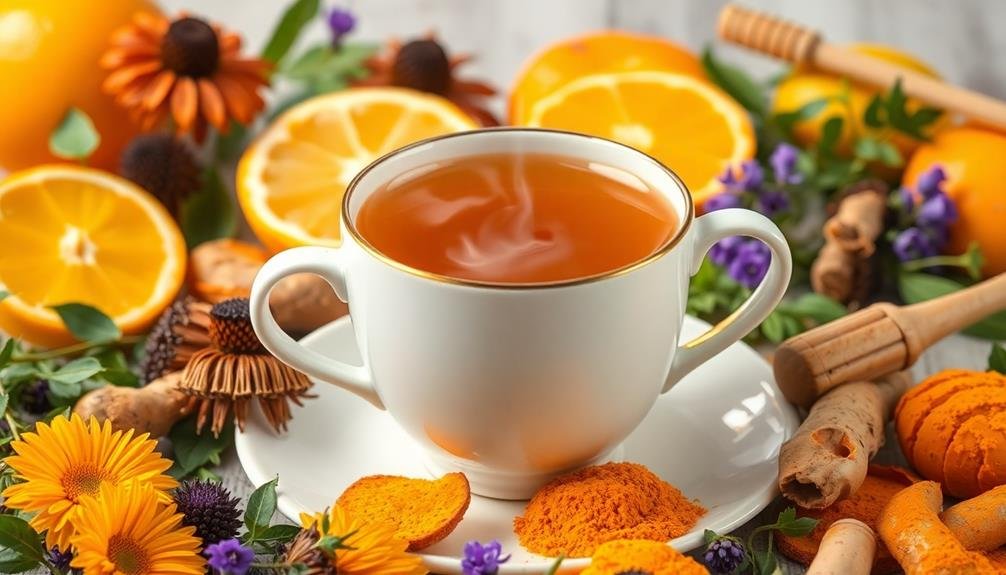
Understanding immune support is fundamental for maintaining your overall health and well-being. Your immune system acts as your body's defense against pathogens, helping you fight off infections and diseases. To support this essential system, you need to focus on a balanced diet, regular exercise, adequate sleep, and stress management. Each of these factors plays a significant role in bolstering your immune function.
Eating a variety of nutrient-rich foods is important. Make sure to include plenty of fruits and vegetables, as they provide essential vitamins and antioxidants that help fend off illness. Staying hydrated is equally important, so drink enough water throughout the day.
Regular physical activity can also enhance your immune response. Aim for at least 30 minutes of moderate exercise most days.
Additionally, prioritizing quality sleep allows your body to repair and regenerate, ultimately strengthening your immune defenses.
Lastly, managing stress is crucial. High-stress levels can weaken your immune system, so consider incorporating relaxation techniques like meditation or deep breathing exercises into your routine.
Key Herbs for Immune Boosting
When it comes to enhancing your immune system, certain herbs stand out for their powerful properties. Echinacea is one of the most popular choices; it's known for its ability to stimulate immune function and reduce the severity of colds.
You might also consider elderberry, which is rich in antioxidants and has been shown to shorten the duration of viral infections.
Ginger is another fantastic option. It has anti-inflammatory and antioxidant effects that help bolster your defense against pathogens.
Turmeric, with its active compound curcumin, offers similar benefits while also promoting overall wellness.
Don't overlook garlic, either. This kitchen staple has been used for centuries to enhance immunity due to its allicin content, which possesses antimicrobial properties.
Finally, astragalus root can provide a boost by increasing the production of immune cells.
Incorporating these herbs into your daily routine can make a significant difference.
Whether you're sipping a tea steeped with these ingredients or adding them to meals, the key is consistency.
Blending Techniques for Herbal Teas

When blending herbal teas, you'll want to start by selecting quality ingredients that complement each other.
Pay attention to ideal steeping times to maximize flavor and health benefits.
Selecting Quality Ingredients
Selecting quality ingredients is essential for creating herbal tea blends that truly boost your immune system. When you're sourcing herbs, look for organic options whenever possible. Organic herbs are grown without harmful pesticides and chemicals, ensuring that you're getting the purest flavors and benefits.
Freshness matters too—dried herbs lose potency over time, so check the packaging date and choose those with a recent harvest.
Next, consider the source of your herbs. Local farmers or reputable online stores specializing in herbal products often provide higher-quality ingredients. You can also grow your own herbs, ensuring freshness and control over what goes into your tea.
Pay attention to the color, aroma, and texture of the herbs. Vibrant colors and strong scents signify fresh herbs rich in essential oils and nutrients. Avoid dull or faded ingredients, as they may lack flavor and potency.
Ideal Steeping Times
Finding the right steeping time is crucial for maximizing the flavors and health benefits of your herbal tea blends. Each herb has its unique properties, requiring specific steeping times to extract their beneficial compounds effectively. Generally, herbal teas should steep for 5 to 10 minutes. However, some herbs like chamomile or peppermint may only need about 5 minutes, while others like hibiscus or rooibos can benefit from a longer steep of 7 to 10 minutes.
To guarantee you achieve the best flavor, pay attention to the color and aroma as your tea brews. If you notice the color intensifying too quickly, it might be time to taste. You can always adjust the steeping time based on your personal preferences. If you enjoy a stronger flavor, let it steep a bit longer, but be cautious, as over-steeping can lead to bitterness, particularly with certain herbs.
Using a timer can help you keep track of your steeping times, making it easier to achieve consistency. Experiment with different blends and steeping times to find your perfect balance. This practice will enhance both your enjoyment and the health benefits of your herbal tea.
Balancing Flavors and Benefits
Creating a harmonious herbal tea blend involves a thoughtful balance of flavors and health benefits. Start by selecting a base herb, like chamomile or rooibos, that provides a pleasant taste and calming effects.
Then, layer in complementary herbs that enhance flavor and add health properties. For instance, if you choose chamomile, consider adding a hint of mint for freshness and ginger for its immune-boosting capabilities.
Pay attention to the ratios. A good rule of thumb is to use about 60% base herbs and 20% each of your complementary herbs. This guarantees the base flavor remains dominant while the benefits of the other herbs shine through.
Taste as you go; adjust the amounts based on your preferences. If you find the blend too strong, add more of the base herb to mellow it out.
Don't forget about the aromatics! Citrus peels or floral notes can elevate your blend, making it more enjoyable to sip.
Finally, remember to jot down your ratios and observations. This way, you can replicate or tweak your favorite blends in the future.
Enjoy the process and discover your unique herbal tea masterpieces!
Essential Ratios for Tea Blends
When it comes to crafting herbal tea blends that effectively boost your immune system, understanding essential ratios is key. Start by focusing on a balanced blend of herbs that serve different purposes. A common ratio is 2:1:1, where you use two parts of a primary immune-boosting herb, one part of an aromatic herb, and one part of a supportive herb.
For example, if you choose echinacea as your primary herb, combine it with one part ginger for flavor and another part chamomile for its calming properties. This balance helps guarantee that you enjoy the flavor while maximizing health benefits.
You can also experiment with a 3:1 ratio if you want to emphasize a particular herb. Just remember, too much of one herb can overpower the blend.
Another helpful tip is to use a teaspoon of dried herbs for every cup of water. This keeps your tea potent without overwhelming your palate.
Adjusting ratios based on personal taste is important, too. Don't hesitate to tweak these guidelines until you find the perfect blend that suits your palate and immune-boosting needs!
Classic Herbal Tea Combinations

When you think about herbal teas, classic combinations often come to mind.
These popular pairings not only taste great but also offer impressive health benefits.
Let's explore some of these timeless blends and what they can do for your immune system.
Popular Herbal Pairings
Discovering the perfect herbal tea blend can elevate your immune-boosting experience, and certain classic pairings stand out for their powerful benefits. These combinations not only taste great but also complement each other to enhance their effects. Here are some popular herbal pairings you might want to try:
| Herbal Pairing | Flavor Profile | Key Features |
|---|---|---|
| Ginger & Lemon | Spicy & Citrusy | Warming, invigorating |
| Chamomile & Lavender | Floral & Soothing | Calming, relaxing |
| Peppermint & Eucalyptus | Fresh & Cool | Revitalizing, respiratory |
Each of these combinations brings unique flavors and aromas to your cup, making your tea-drinking experience more enjoyable. Ginger and lemon create a zesty kick, perfect for those chilly days. Chamomile and lavender offer a soothing blend, ideal for winding down. Meanwhile, peppermint and eucalyptus provide a revitalizing lift, especially during allergy season.
Experiment with these pairings and find out which ones resonate with your taste buds while enhancing your immune support. With the right ratios, you'll turn your herbal tea routine into a delicious ritual that nurtures your body.
Health Benefits Explained
Classic herbal tea combinations not only delight your taste buds but also offer an array of health benefits that support your immune system. When you sip on these flavorful brews, you're not just enjoying a warm drink; you're also bolstering your body's defenses.
Here are three key benefits you'll gain from these herbal blends:
- Antioxidant Power: Many herbs, like green tea and hibiscus, are rich in antioxidants. These powerful compounds help combat oxidative stress, protecting your cells and enhancing your overall immune response.
- Anti-Inflammatory Properties: Ingredients such as ginger and turmeric can reduce inflammation in your body. By incorporating these into your tea, you can help soothe your system and promote better health.
- Digestive Support: Herbal teas like peppermint and chamomile can aid digestion. A healthy gut is essential for a strong immune system, so enjoying these blends regularly can enhance your well-being.
Spices to Enhance Immune Function
How can simple spices transform your immune system? Incorporating spices into your daily routine can remarkably boost your immune function.
For instance, turmeric is packed with curcumin, a powerful anti-inflammatory compound that enhances the immune response. Adding a pinch of this golden spice to your tea not only enriches the flavor but also helps fend off illness.
Ginger is another spice that can work wonders. It's known for its antioxidant properties and ability to reduce inflammation. By steeping fresh ginger in hot water, you create a soothing tea that can combat colds and flu.
Don't forget about garlic! This potent spice contains allicin, which has antimicrobial properties. Adding minced garlic to your meals can enhance your immune defenses, making it harder for pathogens to take hold.
Cinnamon is also worth mentioning. It's loaded with antioxidants and has anti-inflammatory effects, which can help in maintaining a healthy immune system.
Simply sprinkle some cinnamon into your herbal tea for an aromatic boost.
Adjusting Ratios for Personal Taste
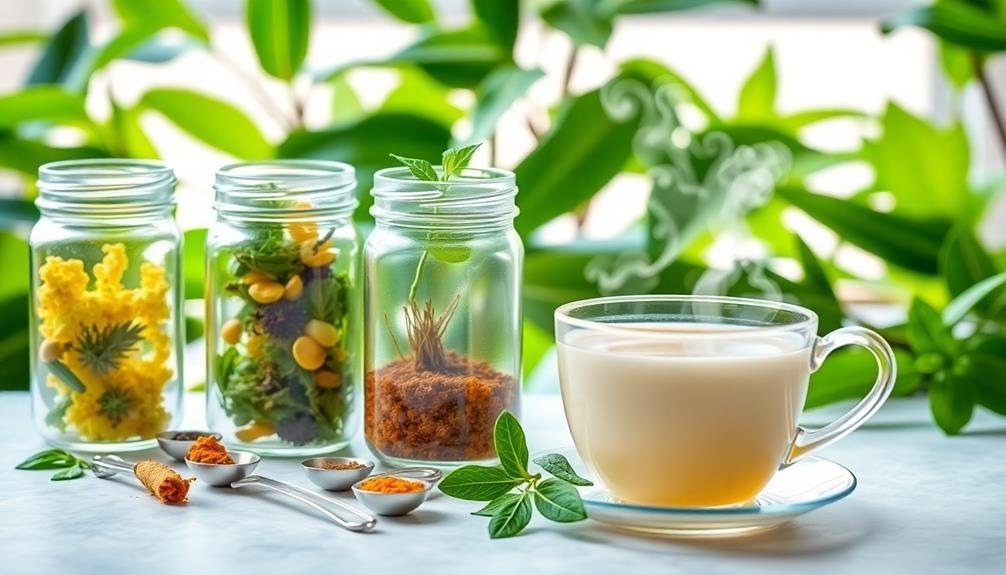
When crafting your herbal tea blends, don't hesitate to experiment with different ingredients to find what suits your palate best.
Balancing flavor profiles is key, so adjust the ratios of spices and herbs until you hit that perfect taste.
Experimenting With Ingredients
Experimentation is key to crafting the perfect immune-boosting herbal tea blend that suits your taste.
Don't be afraid to adjust the ratios of your ingredients to find what feels best for you. Each herb has its unique flavor and health benefits, so play around until you discover your ideal mix.
Here are three tips to help you experiment:
- Start Small: Begin with small batches to test out different ratios. This way, you won't waste ingredients if a combination doesn't work out.
- Keep a Journal: Document your experiments, noting the amounts used and your impressions of the flavor. This will help you refine your blends over time.
- Trust Your Palate: Taste is subjective. If you find a certain herb overpowers the others, adjust the amount accordingly. If you crave more zing, consider adding a splash of citrus or a hint of ginger.
Balancing Flavor Profiles
Balancing flavor profiles is essential for creating a herbal tea blend that not only boosts your immune system but also delights your taste buds. When you experiment with different herbs, it's vital to adjust the ratios to suit your preferences. Here's a simple guide to help you find your perfect balance.
| Flavor Profile | Recommended Ratio | Example Herbs |
|---|---|---|
| Sweet | 2:1 | Licorice root, Stevia |
| Spicy | 1:1 | Ginger, Cinnamon |
| Earthy | 3:2 | Tulsi, Dandelion |
| Citrusy | 1:2 | Lemongrass, Lemon peel |
Feel free to tweak these ratios based on your taste. If you love a strong citrus note, increase the lemongrass. For a sweeter sip, add more licorice root. You can also combine different profiles to create a unique blend that excites your palate. Don't shy away from trial and error—making adjustments as you go is part of the fun. In the end, your herbal tea should be a personal reflection of what you enjoy!
Seasonal Ingredients for Optimal Health
Seasonal ingredients play an essential role in enhancing your immune system and overall health. By incorporating fresh, local produce into your herbal tea blends, you can maximize the benefits while enjoying a delightful taste.
When you focus on what's in season, you're not just supporting local farmers; you're also providing your body with nutrients that align with its needs throughout the year.
Here are three seasonal ingredients you should consider:
- Elderberries (late summer to early fall): Known for their high antioxidant content, elderberries can help fend off colds and flu. They're a great addition to your winter tea blends.
- Citrus Fruits (winter): Oranges, lemons, and grapefruits are rich in vitamin C, which is essential for immune function. Add a splash of fresh juice or zest to your tea for a revitalizing boost.
- Ginger (fall and winter): This warming root is perfect for soothing sore throats and reducing inflammation. Its spicy kick adds flavor and health benefits to your herbal concoctions.
Embrace these seasonal ingredients to create powerful, immune-boosting herbal tea blends that keep you feeling your best all year round!
Preparing Herbal Tea Infusions

Crafting herbal tea infusions is a simple yet rewarding process that allows you to harness the full potential of nature's bounty. To start, gather your chosen herbs, whether they're dried or fresh. Measure out about one tablespoon of dried herbs or three tablespoons of fresh herbs for each cup of water. This ratio provides a robust flavor and maximizes the health benefits.
Next, bring water to a boil, then let it cool slightly; boiling water can scorch delicate herbs. Pour the hot water over the herbs in a teapot or a heatproof container. Cover it to keep the steam and essential oils trapped, allowing the infusion to develop fully. Let it steep for about 5 to 10 minutes, depending on your taste preference and the herbs used.
Once steeped, strain the herbs from the liquid using a fine mesh strainer or cheesecloth. You can enjoy your tea as is or enhance it with honey, lemon, or your favorite sweetener.
Sip slowly, allowing the soothing warmth and immune-boosting properties to envelop you. Enjoy this simple act of self-care as you nourish your body with every cup.
Storing and Preserving Blends
Proper storage is essential for maintaining the potency and flavor of your herbal tea blends. By following a few simple guidelines, you can guarantee that your blends stay fresh and effective for longer periods.
- Use airtight containers: Store your blends in dark, airtight containers to protect them from moisture, light, and air. Glass jars or metal tins work best, as they keep out contaminants and odors.
- Keep them cool: Find a cool, dark place in your kitchen or pantry to store your tea blends. Avoid areas near the stove, oven, or windows where heat and sunlight can degrade their quality.
- Label and date: Always label your containers with the blend name and the date you prepared it. This way, you'll know when to use it by and can easily keep track of your favorites.
Troubleshooting Common Blending Issues

When blending herbal teas, you might run into a few common issues that can affect the taste and effectiveness of your concoctions. One major problem is imbalance in flavor. If a particular herb overpowers the blend, consider reducing its quantity or pairing it with complementary herbs to create a more balanced profile.
Remember, taste-testing during the blending process is key.
Another issue can be brewing temperature and time. If your tea tastes bitter or too weak, you may need to adjust these factors. Delicate herbs often require cooler water and shorter steeping times, while sturdier ones can handle hotter water and longer steeping.
You might also face texture problems, especially if your herbs vary greatly in size. To fix this, chop larger herbs to match the size of smaller pieces, ensuring even extraction of flavors and properties.
Lastly, check your storage methods. If your blends lose potency or flavor too quickly, consider using airtight containers and keeping them away from light and moisture.
Health Benefits of Each Herb
Herbal teas aren't just delightful beverages; they're packed with a range of health benefits that can support your immune system. Each herb in your tea blend contributes unique properties that enhance your overall well-being.
Here are three powerful herbs you might consider:
- Echinacea: Known for its ability to stimulate the immune system, echinacea can help reduce the duration and severity of colds. Regular consumption may keep those pesky bugs at bay.
- Ginger: This spicy root is famous for its anti-inflammatory properties. Ginger can help soothe sore throats and alleviate nausea, making it a perfect companion during cold and flu season.
- Peppermint: Not only does peppermint provide a revitalizing flavor, but it also contains menthol, which can help open up airways and improve breathing. Its soothing effect on the digestive system can also aid in overall health.
Incorporating these herbs into your tea blends can make a significant difference in maintaining your immune health.
Each sip not only warms you up but also fortifies your body against potential invaders. Enjoy the benefits while savoring your herbal brew!
Tips for Daily Immune Support
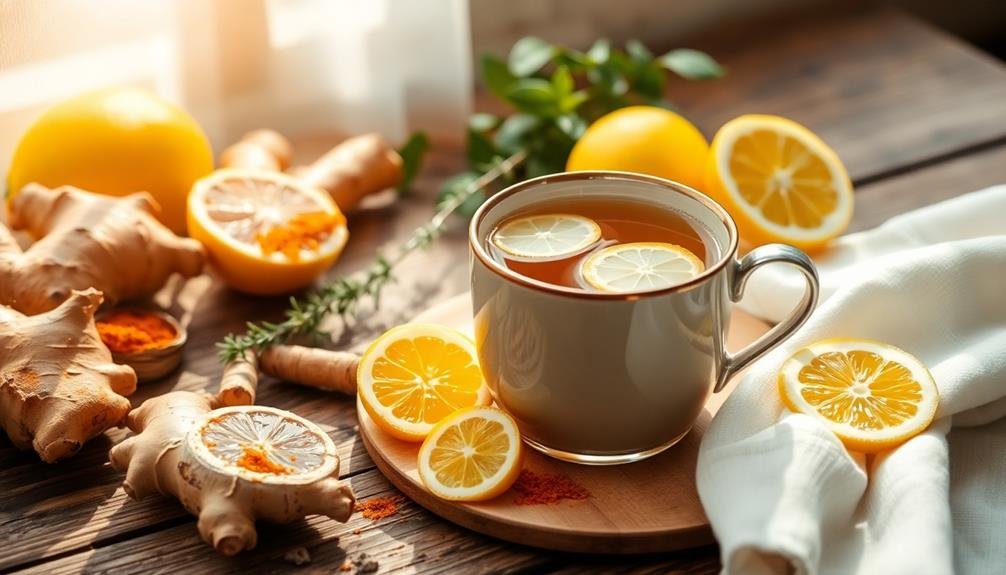
To support your immune system daily, focus on simple, effective habits that can make a big impact.
Start with hydration—drink plenty of water throughout the day. Staying hydrated helps your body function efficiently and flushes out toxins. Incorporate herbal teas, like ginger or echinacea, into your routine for added immune support.
Next, prioritize a balanced diet rich in fruits, vegetables, and whole grains. These foods provide essential vitamins and antioxidants that strengthen your immune response.
Don't forget to include probiotics, found in yogurt or fermented foods, to support gut health, which plays an essential role in immunity.
Regular physical activity is also key. Aim for at least 30 minutes of exercise most days. This boosts circulation and helps your immune cells function better.
Additionally, make sure you're getting enough sleep—7-9 hours each night helps your body recover and recharge.
Frequently Asked Questions
Can I Use Dried Herbs Instead of Fresh Ones?
Yes, you can use dried herbs instead of fresh ones! Just remember that dried herbs are more concentrated, so you'll need less. Adjust your measurements to guarantee your tea still tastes great and delivers the desired effects.
How Often Should I Drink These Herbal Teas?
You can drink herbal teas daily for ideal benefits. Aim for two to three cups, adjusting based on your preference and how your body responds. Listen to yourself and enjoy the soothing experience.
Are There Any Side Effects to Consider?
Yes, there can be side effects. You might experience allergies, digestive issues, or interactions with medications. It's important to monitor how your body reacts and consult a healthcare provider if you have concerns.
Can Children Consume These Herbal Blends Safely?
Yes, children can safely consume herbal blends, but it's essential to guarantee the ingredients are suitable for their age. Always consult a healthcare professional before introducing new herbal remedies to your child's diet.
How Can I Incorporate These Teas Into My Daily Routine?
To incorporate herbal teas into your daily routine, start each morning with a cup, enjoy one during your afternoon break, or sip a calming blend before bed. It'll enhance your relaxation and overall wellness.
In Summary
Now that you've learned about the key herbs, blending techniques, and essential ratios for immune-boosting herbal teas, you're ready to create your own invigorating blends. Experiment with classic combinations and don't forget to store your teas properly for maximum freshness. By incorporating these herbal blends into your daily routine, you'll not only support your immune system but also enjoy a delicious and comforting drink. So, grab your ingredients and start brewing your way to better health!

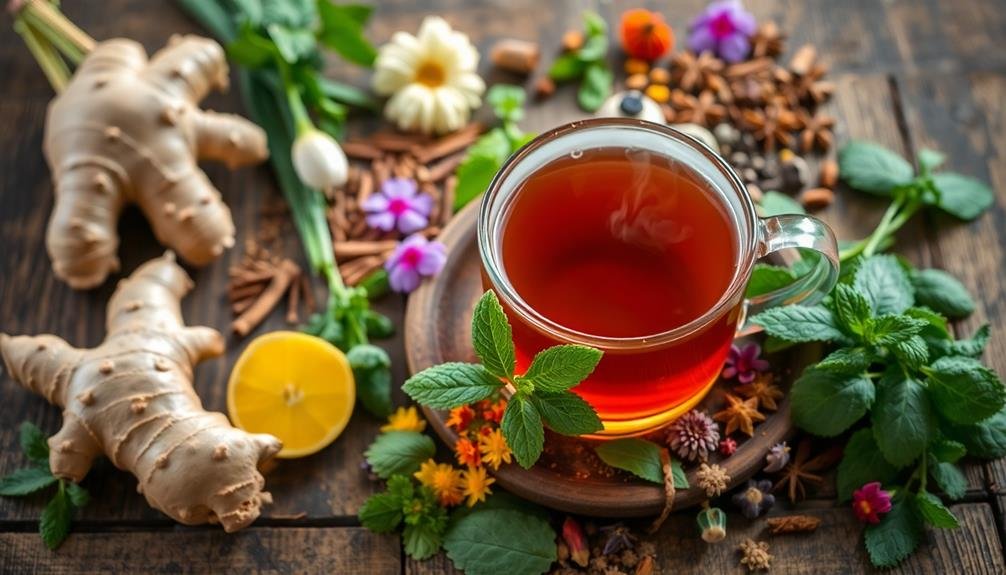
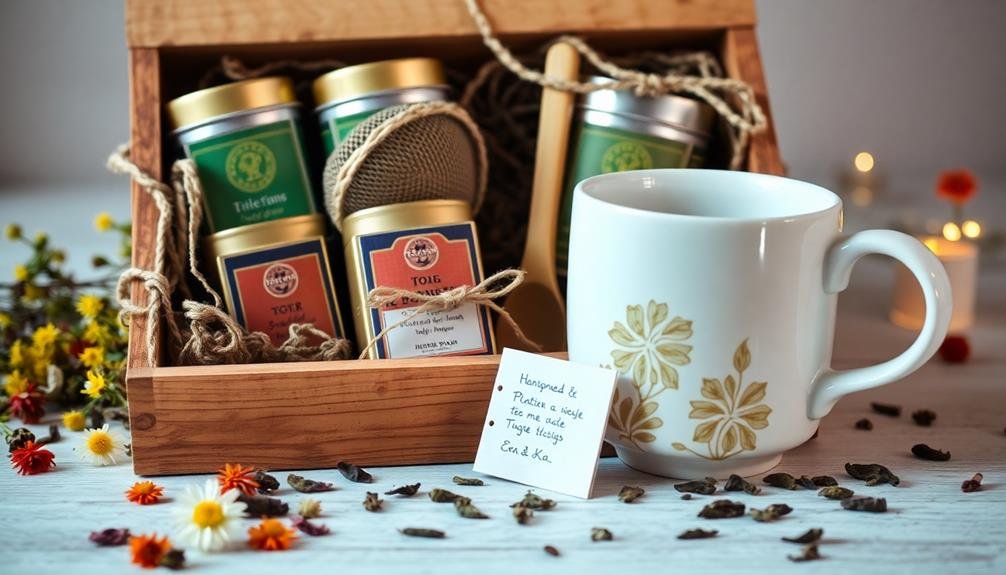
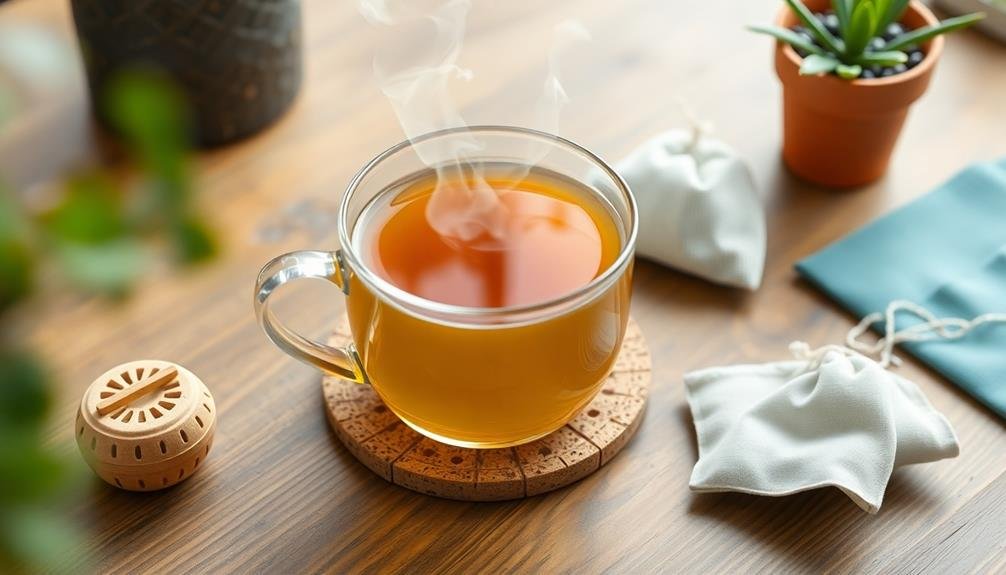
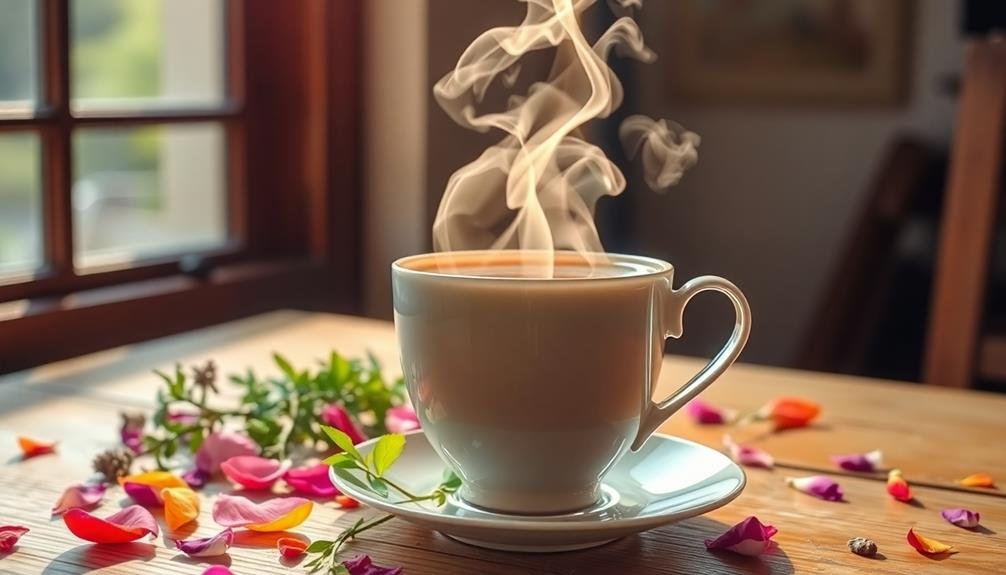
Leave a Reply